Recent Activity

It's in a pot. As long as you don't transfer any "germs" to another pot, you are free to wait and see. I still don't think it's HVX, as I don't see any "inkbleed".
However, it doesn't hurt to be cautious.
bkay

That's not unusual early in the season. Frost damage or sun scorch or both.

Yes, just got a delivery yesterday. Very well packed. Small pips just coming up (it is Maine!) with good roots.

Here are some patterned seedlings of mine:
Blue Jay Tapestry X Karelia seedling
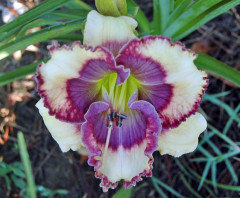
Core Values X Bowtie Affair
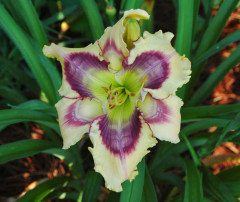
Cowgirl Spurs x Stinger
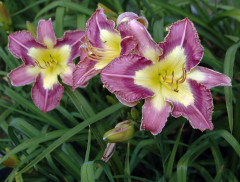
Karelia Kid X This Longing #1 had its best year ever with some scapes 28 inches and 18 buds.
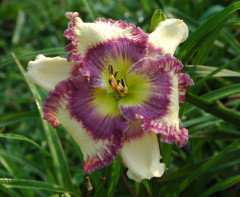
Kiss of Paradise X Facemaker
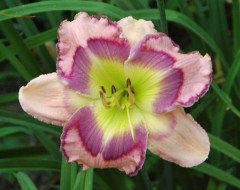
Stenciled Infusion X Aztec Headdress sdlg 3
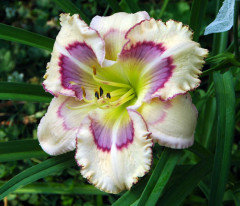
Stenciled Infusion X Aztec Headdress Sdlg 1
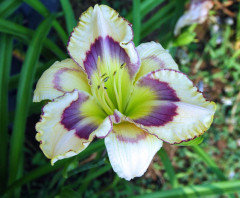
Stenciled Infusion X Royal Cypher
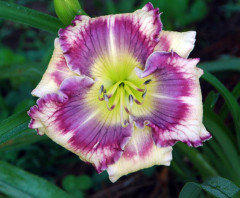
Tully Mars X Venetian Pools was my best-budded new patterned seedling last year. It had 13-14 buds per scape in a dreadful year for bud counts.
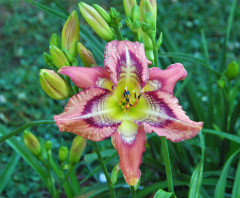
Sword of Justice X Warm in Winter
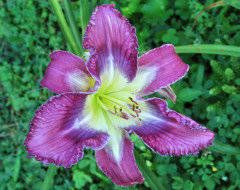
Tides Roll In X All Things to All Men
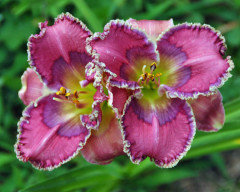
Debra

Take it out of its pot and check the roots.

If you're allowing the plant's pot to sit in water that collects in the cache pot, that is a serious issue. It's best to empty the cache pot after watering or water at the sink and return the pot to its cache pot only after it has stopped draining. BTW, you can reduce the amount of excess water your planting can hold by tipping the pot at a 45* angle after every watering (at the sink).
Regular nutritional supplementation is an essential part of the care regimen for almost all plants grown in pots, monstera among them. An excellent choice for plants is Foliage-Pro 9-3-6. It contains all nutrients essential to normal growth at nutrient ratios preferred by the average plant. It boasts many other attributes as well, among them the fact that it is a complete nutritional supplementation from a single source. It is definitely one product that lives up to what it says in advertisements.
If your plant is not reaching it's full genetic potential, simply staking it is not going to make it healthier or restore it to a more vibrant state. This short piece about Good Growing Practices should be helpful. It will help you avoid nearly all the pitfalls we all encounter at some point along the journey to a green thumb.
Al

bare-rooting (to the degree possible with a monstera)
@tapla (mid-Michigan, USDA z5b-6a), a curiosity of mine (I don't have a monstera): why is bare-rooting more complicated with monstera?

Agree. Everything about it matches Undulata Albomarginata. Mine grows crazy fast too.

Hyperion daylily is my favorite lemon yellow plant. It even has a lovely fragrance and is a strong and vigorous plant. I can send you some if you want - I always have too much!

Which is why I'm reaching out to see if anyone has one. 😁

Wonderful!! I had mine with my succulents but it got really stressed. So I set it in close proximity but not under the light, but it didn't flower this year. So what kind of light does it need to flower?
Deanna

Less sun than from other cacti, these are rainforest canooy plants so stressed by too much sun and heat for that matter. Fort the autumn flowering Thanksgiving, I just leave mine out. My first frosts usually come late and they are in bloom by November. It's the long and cool nights that trigger them to bloom.

I find F. triangularis pretty darn fussy for a ficus, and the variegated form more so. IF one can get the plant through the first few years from rooting they do get a bit easier. I don’t find them worth the trouble, but YMMV.

Magnesium (Mg) is one of the 3 secondary macro nutrients, and compared to the 6 primary and secondary macro-nutrients, Mg is used in the smallest amounts.
Here, I have given Nitrogen (N) the value of 100 because it is the nutrient component most used by most plants. Other nutrients are listed as a weight percentage and parts per 100 parts of N. To read the chart: Phosphorous - plants use 13-19 parts of P or an average of about 16 parts for every 100 parts of N, or 6 times more N than P. Plants use about 45-80 parts of Potassium or an average of about 62 parts for every 100 parts of N, or about 3/5 as much K as N, and so on.
N 100
P 13-19 (16) 1/6
K 45-80 (62) 3/5
S 6-9 (8) 1/12
Mg 5-15 (10) 1/10
Ca 5-15 (10) 1/10
Fe 0.7
Mn 0.4
B(oron) 0.2
Zn 0.06
Cu 0.03
Cl 0.03
M(olybden) 0.003
If your fertilizer contains calcium, you can use Epsom salts (MgSO4) as a source of magnesium. If you are fertilizing at production rates, use/add .625ml/l each time you fertilize.
Al

When pruning your jade, taking note of how the leaves are arranged will help you decide where to prune. Your plant's growth habit is to grow leaves in pairs on opposite sides of the branches/stems, and each node will produce a pair of leaves growing at 90* to the previous leaves at the previous node. So, looking at the end of the branch, if the last pair of leaves are at 6 and 12 0'clock, you can count on the nest pair of leaves that will grow being at 3 and 9 0'clock. This is very useful because pruning a branch will force a new PAIR of branches to grow immediately proximal (closer to the trunk) to the pruning cut. This means you can make a branch turn up, down, left, or right just by pruning it and rubbing off the leaf or new branch that occurs on the side opposite of where you want the branch to grow. So, if you want the branch to grow upward, rub off the new growth at the bottom of the node you have determined will produce branches growing up and down. The branches will reliably grow behind the pruning cut, even if there are no leaves at the node.
I'm sure you noticed how your plant looks like it grows segment by segment. The lines that encircle the branches and stems are a clear indication of where the nodes are. When pruning your plant, it's best to make your pruning cuts distal to (beyond) the node you want to produce new branches. Your plant is fleshy, and you can rely on the stub you left drying up all the way back to the node proximal to (behind) the pruning cut. After 6 months to a year, you'll be able to simply rub the dried stub off with your thumb.
You have the overly large wound crater because you compromised the node by cutting into it when you pruned. Had you bade the pruning cut a half inch away from the trunk or halfway between the nodes, the stub left would have dried up and there would be no wound at all to speak of after you rubbed off the stub.
A tip that would have ensured a much smaller wound than the image shows: Flush pruning cuts should always be avoided when pruning crassula or portulacaria. If you must make a flush cut, wait for it to stop weeping sap (a day), then paint the wounds carefully with waterproof wood glue. This will prevent such a large area of tissue from becoming desiccated and producing a wound so large.
Cinnamon (an antifungal plant product) or any other fungicide will not help you avoid wounds that are caused by pruning in such a way that the node is compromised, nor does it help close the wound. A wound created with an appropriate pruning cut, unless the branch was bigger than a dime, might take about 6 months before it can be rubbed off, and the wound would be inconspicuous after a year or so; whereas, a dime size wound created with an appropriate pruning cut and not sealed might take 5 years or more (depending on the plant's level of vitality and growth rate) to become inconspicuous.
If the images you uploaded are recent, carefully painting the exposed raw tissue with waterproof wood glue will help prevent repeats of the large existing wound. Paint only to the perimeter of the wound. You can use a flat toothpick to spread the glue. After the wound is covered, tip/rotate the plant so the wound is up and level to the horizon to prevent the glue from running over the edges of the wound.
Too, plants are generating organisms as opposed to animals, which are regenerating organisms. Where animals (including humans) heal by regenerating new tissue in the same spatial position as the diseased or damaged tissue, plants are incapable of that type of healing. Plants cover wounds by producing a tissue called callus, which roles over the wound from the edges inward. This covers the wound but does not restore the tissue killed by desiccation.
Al

Don't like them at all, the classics are more elegant in my opinion.

Nothing wrong with that! For sure, to each their own. That's the great thing about plants. There are so many that there really is something for everyone.
And for me, I consider it a blessing if there is a plant I don't like. Because there are SO many that I do. I barely have room for them!

I don't know if you can plant it deeper but you could treat it like a big cutting. Just lop it off, let the end callous over for a couple of days, then replant it in some nice new quick-draining soil. Don't water for two weeks, then start watering sparsly. That's how I started mine from a big branch off the end of a neighbor's enormous jade. I wish I could show you a picture of the cutting but suffice it to say, what became the trunk was about 2" in diameter.

You can very easily prune your plant so it has a single trunk with virtually no concern that the pruning will cause the plant life threatening harm.
The trick to pruning jades and portulacaria is to leave a very short stub. You don't want to cut into the node on the trunkline that gave rise to the branches you're viewing as subordinate, or competing trunks. When you leave a short stub, sealing the wound is unnecessary because the wound will dry back to the first node proximal (closer to the roots or trunk) to the cut. Once the pruning is done, in 6 months to a year you'll be able to simply rub off the desiccated tissue with your thumb, making it difficult to tell it was even pruned. Cutting flush to the lower order branch (the branch the you're pruning is attached) or trunk will cause tissue to dry out in the immediate vicinity of the wound, such that the wound will be larger, deeper, more unsightly, and it will take longer for callus tissue to cover the wound.
I would advise that you carefully cover the existing wounds with waterproof wood clue, which will prevent the wounds from growing larger due to desiccation. Use a flat toothpick or similar item to carefully paint the wound only. Try not to overlap the wound and get glue on the periderm (bark); this, because it will make a lump when the callus rolls over the glue.
Al

@ken_adrian Adrian MI cold Z5 generally speaking, when jade plants are getting the appropriate amount of light, their leaves will turn more of a light green or gold. Jades with dark green leaves are usually either being overfertilized or aren't receiving an appropriate amount/intensity of light, or both. However, there are different cultivars of jade which have slightly different leaves, so it's difficult to know for sure without knowing the specifics of which jade it is. Most jade plants that I see posted on plants forums or groups are very etiolated, but that one isn't, so for its first 20 years it received appropriate light. Can't say if it currently is since they grow very slowly and it likely hasn't had time to respond to its current light situation. Seems like many people place them where "they'll look good in the room" rather than where they'll receive the light that they need.
Deanna






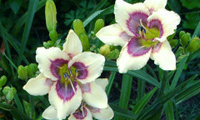


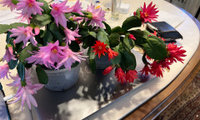
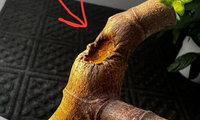
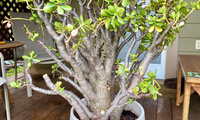
Thanks everyone. i'm a sucker for spiders so decided to purchase from Woodhenge